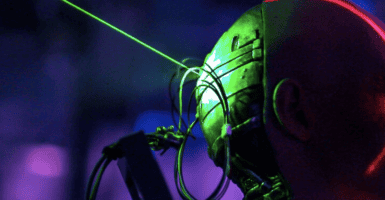Wear Your Favorite Science Fiction, Because Reading Is So 20th Century
This article is more than 2 years old
 I’m one of those people who feels what I’m reading if I’m really into it. I wince, I avert my gaze, my breathing speeds up, I laugh, I cry. But for people who want more of a visceral experience when they read, students in an MIT Media Lab class have produced a final project called “Sensory Fiction,” a wearable vest that allows readers to experience what the protagonist of a story is feeling.
I’m one of those people who feels what I’m reading if I’m really into it. I wince, I avert my gaze, my breathing speeds up, I laugh, I cry. But for people who want more of a visceral experience when they read, students in an MIT Media Lab class have produced a final project called “Sensory Fiction,” a wearable vest that allows readers to experience what the protagonist of a story is feeling.
I’ve never been more impressed by or jealous of another professor’s syllabus. How awesome would it be to take MIT’s Science Fiction to Science Fabrication class? The class focuses on some sci-fi classics such as William Gibson’s Neuromancer, Philip K. Dick’s Do Androids Dream of Electric Sheep?, works by Ray Bradbury, Arthur Clarke, Isaac Asimov, and more, and combines them with nonfiction reading about cyborgs, transhumanism, nanotechnology, and more. It’s not hard to imagine such a class inspiring such an incredible final project.

Three students developed the Sensory Fiction wearable book using a network of sensors and actuators that help readers actually experience the physical sensations and emotions of the protagonists. Appropriately enough, they used James Tiptree’s Hugo Award-winning novella The Girl Who Was Plugged In as the prototype for their project. To experience the Sensory Fiction, a reader wears a vest that contains a heating device to simulate sunlight or cold, a compression system to convey a sense of enclosure or claustrophobia, padding that produces vibrations, and programmable LEDs that set the mood. The vest adds a sense of physical reality to the book, enhancing what readers are likely already feeling as they turn the pages.
One of the questions raised by the project and the course is the nature of the connection between such devices and actual emotions. How close is a simulated or manufactured sensory experience to the real thing? The trajectory of futuristic devices implies that the two experiences are growing closer to converging all the time, especially when it comes to the development of robots and AI who might appear to experience emotions because of the verisimilitude of the simulated ones. I think there will probably come a point in the future where it’s difficult, if not downright impossible, to distinguish between “organic” emotions and computer-generated ones, which is one of the questions Ray Bradbury raises in I Sing the Body Electric! in which an electric grandmother by all appearances loves and is loved by the children she helps raise.
Now fans can read their sci-fi and wear it too. The future is indeed bright.












